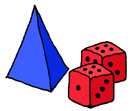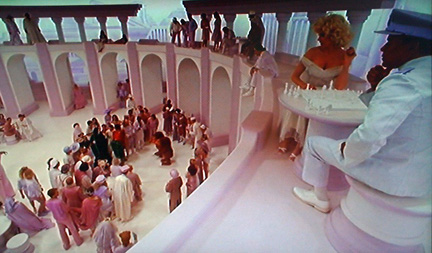 Monochrome
Chess Monochrome
Chess
Designed by Andrew Looney
Motivation
Why play Chess using pieces of just one color? Because it's
weird, that's why! It violates ages-old convention, and will
confound and befuddle on-lookers. As with Icehouse, you will
attract attention when you play this game in a public place.
But it differs from Icehouse, in that on-lookers understand enough
about what's going on to know that something is very wrong. Icehouse
looks abstract and alien; Monochrome Chess, on the other hand,
breaks traditional rules and smashes conventional thinking. And
that's exactly the point of Monochrome Chess - to shake up people
who see it being played, to distort their sense of reality. Half
of the fun of Monochrome Chess is watching people's reactions
when, for the first time, they realize just what it is that you
are doing.
The other half of the fun comes from the fact that Monochrome
Chess requires unconventional thinking on the part of the players.
To play Monochrome Chess, you need to unlearn many of the strategies
and techniques you know from Normal Chess. To be good at Monochrome
Chess, you need to learn to think in new ways. You might say
it's a workout for the brain. (Of course, if you don't know how
to play Normal Chess, or you don't enjoy using your brain, these
benefits of Monochrome Chess may mean little to you.)
Setup
To play Monochrome Chess, you will need 2 identical Chess
sets. Set up as you would for Normal Chess, except use the same
color on both sides of the board. If you're using white, for
example, put the black pieces away - you won't need them.
If you have a folding Chess board, set it up so that the fold
line runs parallel to the rows of Chessmen. This will make the
Centerline (a theoretical boundary used in Monochrome Chess)
more noticeable.
The usual rules for setting up the board, of the white square
corner being positioned on the right side and the Queens going
on their own color, are discarded. Just make sure that the two
Queens face each other, i.e. one goes on her color, the other
one does not.
Playing The Game
To decide who goes first, hold your hands out to your opponent,
with one hand empty and the other concealing a single pawn. Tell
your opponent to choose the hand containing the pawn - if they
guess correctly, they go first. Otherwise, you do. Then play
Chess as usual, with the following exceptions:
- The Centerline divides your pieces from those of your opponent.
Any piece positioned on your side of the Centerline belongs to
you - only you may move it. The upshot of this is that anytime
you move a piece across the Centerline, it suddenly becomes your
opponent's piece.
- You may only capture pieces belonging to your opponent, i.e.
pieces on the other side of the Centerline.
- All pieces move as they normally do except for Pawns, which
can move in either direction. Nothing special happens to Pawns
that advance to the 8th square. Pawns may move 2 spaces towards
the center line anytime they are in one of the Pawns' normal
starting squares. As in Normal Chess, pawns may only move forward
if the path is unobstructed, and they may only capture diagonally.
- No limitations are imposed on Castling, except that no pieces
may obstruct the path between King and Rook. In other words,
the rule that neither piece have been moved prior to a Castle
and the rule that prohibits Castling across Check are discarded.
- The Kings may be captured, just like any other piece. There
is no requirement to announce that a King is threatened, i.e.
you never have to say "check."
- The game can ends as soon as one player runs out of pieces,
i.e. as soon as one side of the Centerline is devoid of pieces.
Note that a player with only one piece remaining can force the
end of the game by moving it across the Centerline.
- A player may not "reject" the move of their opponent.
If a player moves a piece across the Centerline, the opponent
cannot simply move it back to its original square. Example: If
John moves a Queen from square A (on his side of the board) to
square B (on Lisa's side of the board), Lisa may not immediately
move the queen back to square A. She may move it to a different
square, C, on John's side, but she can't simply "reject"
John's move. Note however that the Queen may be moved back to
square B in future plays - the "No Rejections" rule
only applies to a pair of sequential moves.
- If both players agree that the game has reached a stalemate
and no more pieces will ever be taken no matter how long they
play, then the game ends. The winner is determined via the normal
scoring system
Scoring
Each player gets points for the pieces they capture. Player
with the highest score wins. Scores are assigned as follows:
| King |
10 points |
| Queen |
8 points |
| Rook |
5 points |
| Bishop |
4 points |
| Knight |
3 points |
| Pawn |
1 points |
 Historical
Notes Historical
Notes
The story begins with Bill & Ted. Like most sequels, "Bill
& Ted's Bogus Journey" is, well, pretty bogus. It does
have its moments, but on the whole it's pretty lame compared
to Bill & Ted's Excellent Adventure (which is actually pretty
excellent).
Kristin and I went to see the Bogus Journey when it was debuted
in 1991, and there was one thing I loved about it. Part of their
Bogus Journey includes (Spoiler Alert!) a trip to Heaven, and
everything in Heaven is pure white... including the game pieces!
Well, that's how I always remembered it, anyway. I finally
saw the crucial frames again this week, and as you can see from
this low-grade screen-grab, a lot of stuff (clothing in particular)
is simply faded, not white. But I remembered the important thing
correctly: in Heaven, Chess is played with pieces that are all
the same color.
I was immediately inspired to create a real game you could
play with an all-white chess set, and Monochrome Chess was the
result. It remains a chess variant that I think is both cool
and unique, and inventing it was an important step in my career
as a game designer. It later inspired Martian
Chess.
And it might not have happened if it weren't for Bill &
Ted.
|
 Monochrome
Chess
Monochrome
Chess




